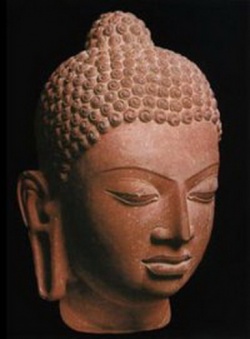Difference between revisions of "Ear lobes, the Buddha’s"
| Line 1: | Line 1: | ||
[[File:EarLobes.jpg|thumb|250px|]] | [[File:EarLobes.jpg|thumb|250px|]] | ||
| − | The [[ear lobe]] ([[kaṇṇapatta]]) is the soft nodule that hangs below the [[pinna]] of the outer ear. On both ancient and modern [[Buddha]] statues in all cultures the [[earlobes]] are depicted as elongated and usually with a hole in them. Most [[Buddha]] statues are meant to be [[symbols]] of the [[enlightened]] state as much as they are portraits of the [[Buddha]] himself. However, the elongated [[ear lobes]] on statues are the survival of a distant {{Wiki|memory}} of what the [[Buddha]] actually looked like. In ancient {{Wiki|India}} men and women commonly wore [[ear plugs]]. Children’s [[ear lobes]] were pierced and a small clay cylinder was put in the holes. As the child grew, increasingly large cylinders were put in the lobes until they had stretched enough to accommodate plugs with diameters of up to 6 centimetres. Hundreds of these objects have been found by archaeologists and are displayed in some museums in {{Wiki|India}}. Prince [[Siddhattha]] would have worn such [[ear plugs]] when he was a lay man and would have taken them off when he renounced the world, leaving his [[ear lobes]] elongated. See Physical Appearance. | + | The [[ear lobe]] ([[kaṇṇapatta]]) is the soft nodule that hangs below the [[pinna]] of the outer {{Wiki|ear}}. On both ancient and modern [[Buddha]] [[statues]] in all cultures the [[earlobes]] are depicted as elongated and usually with a hole in them. Most [[Buddha]] [[statues]] are meant to be [[symbols]] of the [[enlightened]] state as much as they are portraits of the [[Buddha]] himself. However, the elongated [[ear lobes]] on [[statues]] are the survival of a distant {{Wiki|memory}} of what the [[Buddha]] actually looked like. In ancient {{Wiki|India}} men and women commonly wore [[ear plugs]]. Children’s [[ear lobes]] were pierced and a small clay cylinder was put in the holes. As the child grew, increasingly large cylinders were put in the lobes until they had stretched enough to accommodate plugs with diameters of up to 6 centimetres. Hundreds of these [[objects]] have been found by archaeologists and are displayed in some museums in {{Wiki|India}}. {{Wiki|Prince}} [[Siddhattha]] would have worn such [[ear plugs]] when he was a lay man and would have taken them off when he renounced the [[world]], leaving his [[ear lobes]] elongated. See [[Physical]] Appearance. |
| − | Ear Ornaments of Ancient India, Michel Postel, 1989. | + | {{Wiki|Ear}} Ornaments of {{Wiki|Ancient India}}, Michel Postel, 1989. |
{{R}} | {{R}} | ||
[http://www.buddhisma2z.com/content.php?id=119 www.buddhisma2z.com] | [http://www.buddhisma2z.com/content.php?id=119 www.buddhisma2z.com] | ||
[[Category:Buddhist Terms]] | [[Category:Buddhist Terms]] | ||
[[Category:Buddha Shakyamuni]] | [[Category:Buddha Shakyamuni]] | ||
Revision as of 00:50, 4 September 2013
The ear lobe (kaṇṇapatta) is the soft nodule that hangs below the pinna of the outer ear. On both ancient and modern Buddha statues in all cultures the earlobes are depicted as elongated and usually with a hole in them. Most Buddha statues are meant to be symbols of the enlightened state as much as they are portraits of the Buddha himself. However, the elongated ear lobes on statues are the survival of a distant memory of what the Buddha actually looked like. In ancient India men and women commonly wore ear plugs. Children’s ear lobes were pierced and a small clay cylinder was put in the holes. As the child grew, increasingly large cylinders were put in the lobes until they had stretched enough to accommodate plugs with diameters of up to 6 centimetres. Hundreds of these objects have been found by archaeologists and are displayed in some museums in India. Prince Siddhattha would have worn such ear plugs when he was a lay man and would have taken them off when he renounced the world, leaving his ear lobes elongated. See Physical Appearance.
Ear Ornaments of Ancient India, Michel Postel, 1989.
